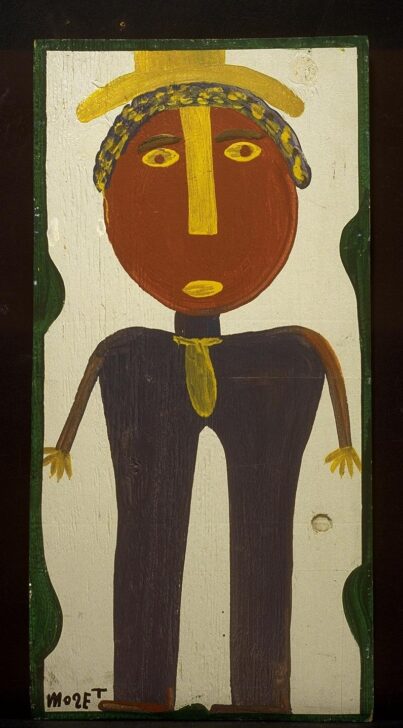Self-Portrait
Mose Tolliver

Description
Annie Tolliver
United States, born 1950
Self-Portrait
after 1990
Oil on plywood
Mose Tolliver
United States, circa 1920–2006
Self-Portrait
late 20th century
Mixed media and house paint on plywood
Gifts of the Daniel and Harriet Fusfeld Folk Art Collection, 2002/1.192 and 1.193
Mose Tolliver began painting with house paints after a work accident left him with long hours to spend at home. After years of selling paintings from his front yard, he was eventually “discovered” when he participated in the 1982 Corcoran Gallery of Art exhibition Black Folk Art in America, 1930–1980 in Washington, DC.
Mose’s daughter Annie started painting to help her father when he became so popular that he couldn’t paint fast enough. She now paints independently, in a more detailed style than her father.
(Out of the Ordinary, 2010)
One of the most prolific self-taught artists, Mose Tollivar began painting after becoming disabled in a work-related accident during the late 1960s. Unable to continue his previous line of work, Tollivar was encouraged to start painting by his former employer. At first, he sold his artwork from the yard of his Montgomery, Alabama home, but within a few years his work was part of the Corcoran Gallery’s exhibition Black Folk Art in America.
Tollivar’s work is characterized by flat, simple images of people and animals, which are usually depicted in an unconventional manner. In Self-Portrait, Tollivar represents himself standing without the use of crutches or a walker. His face and hair contain shades of yellow, and his legs are disproportionately longer than his torso. Because Mose Tollivar includes a great deal of personal iconography in his work, the artists’ sturdy, supportive legs could symbolize how his injured legs have facilitated and supported his successful artistic career. They could also represent the artist as he was before his accident or how he hopes he will be again one day.
Lindsay Meehan
Modern and Contemporary Art Intern
2002
Usage Rights:
If you are interested in using an image for a publication, please visit https://umma.umich.edu/request-image/ for more information and to fill out the online Image Rights and Reproductions Request Form.